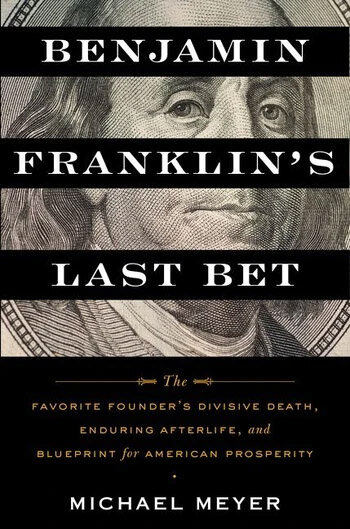Benjamin Franklin’s Last Bet
Philanthropy is about betting on the future. And while certainly not unique to America, American philanthropy has a peculiar and enduring capacity to shape our world and the lives of generations hence. Whether we are supporting disaster relief, the performing arts, or our alma mater’s endowment, as we engage in philanthropy, we imagine the future lives we are affecting. As Bill Gates once noted in the 1990s, the measure of accomplishment is in the number of lives you can save. Still, few of us would imagine that our philanthropy might reverberate through centuries. Not so, Benjamin Franklin.
In Benjamin Franklin’s Last Bet, Michael Meyer, a professor of English at the University of Pittsburgh, illustrates in vivid detail not only how Franklin—printer, statesman, diplomat, inventor of the lighting rod—was present at the creation of so much of early U.S. history, he was equally essential to shaping its philanthropic character across more than two centuries. Franklin was among the founders of the University of Pennsylvania, as well as Philadelphia’s first free library, its fire department, and hospital—a project he launched using, perhaps, the very first matching grant scheme. Long before Elon Musk made his patents for Tesla Motors open source, Franklin never sought licenses or patents for his inventions—which also included bifocals, the Franklin stove, and improvements to the odometer and the rocking chair—instead viewing their use and dissemination as a public good. He was also the progenitor of what today we call microfinance.
Meyer uses a close read of primary source materials from the National Archives and the Library of Congress as well as archives in Boston and Philadelphia, including ledger books and Franklin’s letters to and from his wife, Deborah—whom he scarcely saw for the last decades of her life, while he served as an agent and diplomat in Europe. Putting to bed the myth that Franklin was a self-made man, Meyer rightly elevates his wife, her wealth, and her family connections as critical to Franklin’s continued business success, eclipsing Franklin’s own brother, who loaned him the money for his start in Philadelphia. And Meyer doesn’t turn away from finding part of that success in Franklin’s ownership of slaves, whom he politely described as “servants,” even while publishing abolitionist tracts. While not a biography in full, Last Bet may be as close to an understanding of who Franklin was at the time of his death as we are likely to find.
As with many of the Founding Fathers, Franklin’s complex life has been and continues to be a cipher for the American character; not only was his life interesting and extraordinary, but his ideas and persona—for better and for worse—remain a fixed, if mutable, constellation in American culture. By the age of 42, when he retired from actively running his printing business, Franklin was already the publisher of the Pennsylvania Gazette, colonial America’s largest newspaper, and the creator of Poor Richard’s Almanack, an annual compendium of wit, wisdom, and weather that was widely read throughout the colonies and across Europe (its readers included France’s King Louis XVI). Franklin would go on to a second career as a colonial postmaster, Pennsylvania’s agent to the English crown, the country’s first diplomat, and a signer of the Declaration of Independence, the Treaty of Versailles that ended the war, and the U.S. Constitution. An estimated 20,000 of Philadelphia’s 28,000 inhabitants turned out for his funeral.
Upon Franklin’s death in 1790, the cities of Boston, the place of his birth, and Philadelphia, the city that made him rich, each received bequests of £1,000 ($175,000 today) in trust to invest and support apprenticed tradesmen, staking them with loans to create small businesses. Franklin believed that free and independent tradesmen—not unlike Thomas Jefferson’s yeoman farmer—were an essential bulwark of the new self-governing republic. But this was no mere gift of a generous old man recalling his early luck. Franklin’s will required that a century after his death, both cities demonstrate that they had handled the funds well—and if not, the money would be returned to his heirs—only then could the cities consider two options: using the funds to create institutions of public benefit, or continue the small business loan scheme. What’s more, at the two-century mark, those investments would again have to be reviewed and revisited. Long before “donor intent” was a watchword in the development departments of nonprofit organizations, out of hubris or cheek, Franklin helped frame the debate on how private funds in public hands could be managed and used—in effect shaping American philanthropy itself.
Franklin’s will required that a century after his death, both cities demonstrate that they had handled the funds well—and if not, the money would be returned to his heirs.
Franklin’s scheme was to use the compounded interest of his bequest to fund the loans. Between his death and 1890, thousands of tradesmen—and they were all men, and white men at that—in Boston and Philadelphia received small loans to be paid back with 5 percent interest over 10 years. And while many did repay the loans, more than a few did not. What’s more, particularly in Philadelphia, the funds were not well managed and only showed a marginal return. Equally problematic was that Franklin, as foresighted as he was, did not anticipate the coming industrial revolution that continuously reshaped the urban centers of American life across the 19th century. In fact, the apprentice system which Franklin had sought to leverage was all but a memory a few decades after his death.
All this might have been an interesting coda to Franklin’s life, but that, as Meyer reminds us, “every generation discovers Franklin for themselves.” So too, in 1890 as the cities of Boston and Philadelphia reconciled their first-century’s efforts, Franklin’s intent to perpetuate his scheme became a moment for debate on how money in public trust should be managed and how closely donor intentions should be followed. Meyer (whose specialty is nonfiction writing) describes with almost Grisham-like pacing how Franklin’s heirs attempted—and failed—to claw back the bequest, the news of which sensationalized the otherwise bureaucratic process of deciding how best to reinvest the roughly $175,000 ($6 million today). Philadelphia’s wrangling only subsided in the shadow of the stock market crash of October 1929. While a largely ineffective home-loan program was established—making 95 loans in 70 years—the city directed the majority of its funds, alongside $5 million in matching grants raised, ironically, by the one-time lawyer for the Franklin heirs, to help construct a new science wing for the Franklin Institute, independently founded in 1825 and today a highly regarded center for public science education.
If Philadelphia’s debate had been sensational, Boston’s was far more purposeful, though equally contentious. Where Philadelphia had narrowly avoided turning its bequest insolvent, Boston had managed far better and was able to think bigger. And while Franklin’s bequest almost went to fund a citywide network of public bathhouses, by 1908—with the help of a matching gift from Andrew Carnegie—Boston opened the Institute of Technology (Franklin’s name was added later), a technical school primarily open to the city’s poor. In addition, beginning in 1962, Boston provided more than 1,400 loans to medical students with financial need.
Despite its more-than-two-century sweep, Meyer’s evident enthusiasm for his subject and his effortless weaving of Franklin’s charm and wit with the book’s central theme, carries this narrative up to and beyond the effective termination of Franklin’s bequest in 1990. The funds themselves were never, on their own, transformative, and never attained the value Franklin had hoped the long-term investment would deliver. Still, the purpose, management, and distribution of the funds helped shape and, in turn, were shaped by, the evolution of finance and philanthropy in America—across three very different centuries.
It could be said that he was the first American philanthropist: the first to embrace philanthropy as a private instrument for effecting public good; a pioneer in creating mechanisms to measure effectiveness and to sustain long-term growth, while providing near-term benefit; and an example that echoes from the birth of the republic to our present.
The Franklin funds were among the first to be managed in trust by a municipality, as were the public foundations created to control the funds at the turn of the 20th century. By 1990, Massachusetts had 23,000 such public trusts. In 1993, after public hearings, legal wrangling, and moral hand wringing—although courts had ruled that there was no obligation to distribute the funds to the Benjamin Franklin Institute of Technology—public sentiment prompted both city and state to direct the proceeds of the bequest (now worth almost $5 million) to the school. In 2022, the school was renamed the Benjamin Franklin Cummings Institute of Technology (now Franklin Cummings Tech), following a $12.5 million gift from the Cummings Foundation. In Pennsylvania, the state legislature split what remained of the bequest between the Franklin Institute and a Ben Franklin Fund at the Centre Foundation, a community foundation located far from the city that made Franklin famous.
Benjamin Franklin has been described as “the first American,” and while not the first American to engage in philanthropy (John Harvard’s 1631 bequest might be first among others), it could be said that he was the first American philanthropist: the first to embrace philanthropy as a private instrument for effecting public good; a pioneer in creating mechanisms to measure effectiveness and to sustain long-term growth, while providing near-term benefit; and an example that echoes from the birth of the republic to our present. Although Franklin is likely to never have imagined the complexity of our times, that his bequest endures in the lives of the people of Boston and Philadelphia, is a good sign that his bet on the future was a success.
Daniel X Matz is contributing editor at Philanthropy News Digest.








